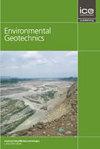Perspectives of 3D Probabilistic Subsoil Modeling for BIM
IF 2.2
4区 工程技术
Q3 ENGINEERING, GEOLOGICAL
引用次数: 0
Abstract
Building information modeling (BIM) in the planning and construction of infrastructure projects, such as roads, tunnels, and excavations, requires the generation of comprehensive 3D subsoil models that encompass relevant geological and geotechnical information. Presently, this process relies on the deterministic interpolation of discrete data points obtained from exploratory boreholes and soundings, resulting in a single deterministic prediction. Commonly employed interpolation methods for this purpose include radial basis function and kriging. This contribution introduces probabilistic methods for quantifying prediction uncertainty. The proposed modeling approach is illustrated using simple examples, demonstrating how to use sequential Gaussian and Indicator Simulation techniques to model sedimentary processes such as erosion and lenticular bedding. Subsequently, a site in Munich serves as a case study. The widely used industry foundation classes (IFC) schema allows the integration of the model into the BIM environment. A mapping procedure allows transferring voxel models to the IFC schema. This article discusses the significance of incorporating uncertainty quantification into subsoil modeling and shows its integration into the BIM framework. The proposed approach and its efficient integration with evolving BIM standards and methodologies provides valuable insights for the planning and construction of infrastructure projects.面向BIM的三维概率底土建模视角
建筑信息模型(BIM)在道路、隧道、开挖等基础设施项目的规划和施工中,需要生成包含相关地质和岩土信息的全面的三维底土模型。目前,该过程依赖于从勘探钻孔和测深中获得的离散数据点的确定性插值,导致单一的确定性预测。常用的插值方法有径向基函数法和克里格法。这篇文章介绍了量化预测不确定性的概率方法。通过简单的例子说明了提出的建模方法,演示了如何使用顺序高斯和指标模拟技术来模拟沉积过程,如侵蚀和透镜状层理。随后,慕尼黑的一个场地作为案例研究。广泛使用的行业基础类(IFC)模式允许将模型集成到BIM环境中。映射程序允许将体素模型转换为IFC模式。本文讨论了将不确定性量化纳入底土建模的重要性,并展示了其与BIM框架的集成。所提出的方法及其与不断发展的BIM标准和方法的有效集成为基础设施项目的规划和建设提供了有价值的见解。
本文章由计算机程序翻译,如有差异,请以英文原文为准。
求助全文
约1分钟内获得全文
求助全文
来源期刊

Environmental geotechnics
Environmental Science-Water Science and Technology
CiteScore
6.20
自引率
18.20%
发文量
53
期刊介绍:
In 21st century living, engineers and researchers need to deal with growing problems related to climate change, oil and water storage, handling, storage and disposal of toxic and hazardous wastes, remediation of contaminated sites, sustainable development and energy derived from the ground.
Environmental Geotechnics aims to disseminate knowledge and provides a fresh perspective regarding the basic concepts, theory, techniques and field applicability of innovative testing and analysis methodologies and engineering practices in geoenvironmental engineering.
The journal''s Editor in Chief is a Member of the Committee on Publication Ethics.
All relevant papers are carefully considered, vetted by a distinguished team of international experts and rapidly published. Full research papers, short communications and comprehensive review articles are published under the following broad subject categories:
geochemistry and geohydrology,
soil and rock physics, biological processes in soil, soil-atmosphere interaction,
electrical, electromagnetic and thermal characteristics of porous media,
waste management, utilization of wastes, multiphase science, landslide wasting,
soil and water conservation,
sensor development and applications,
the impact of climatic changes on geoenvironmental, geothermal/ground-source energy, carbon sequestration, oil and gas extraction techniques,
uncertainty, reliability and risk, monitoring and forensic geotechnics.
 求助内容:
求助内容: 应助结果提醒方式:
应助结果提醒方式:


